- Home
- insider picks
- news
- I made Paul Hollywood's classic scones. They don't deserve a handshake, but the buttery flavor was spot-on
I made Paul Hollywood's classic scones. They don't deserve a handshake, but the buttery flavor was spot-on
Maria Noyen

- Paul Hollywood is a famous British TV personality and co-host of "The Great British Baking Show."
- Hollywood is an expert on all things baking. I, on the other hand, am anything but.
I've been a fan of "The Great British Baking Show" for years, but I could never see myself having what it takes to be one of the bakers selected to compete in the program.
In truth, I'm as amateur a baker as they come, but that doesn't mean I don't love experimenting with new recipes. And for the most part, my attempts have been successful. From beloved family recipes to desserts celebrities have said are their go-tos, I'm all for having fun in the kitchen, even if things don't always turn out perfectly.
With that in mind, I set my sights on a new baking challenge: Paul Hollywood's classic scones recipe. Here's how it went.
Paul Hollywood, often dubbed the "king of bread," is a legend in the world of baking.
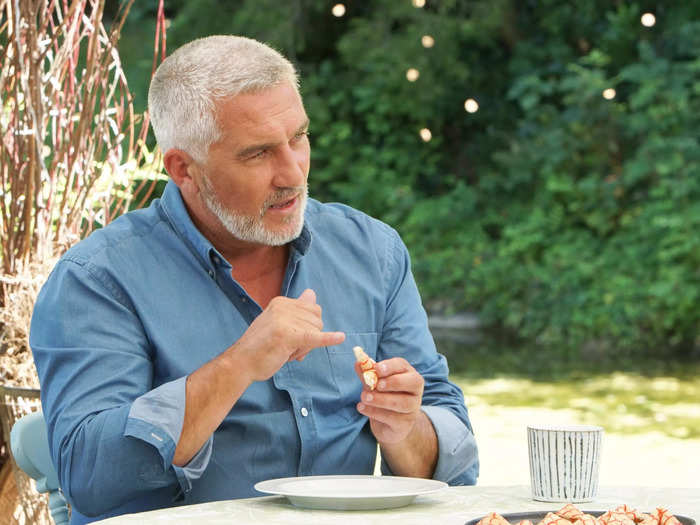
Hollywood, 57, has been a judge on "The Great British Baking Show" since its first episode aired in 2010.
He's known for playing into a "bad cop" persona on the show, delivering the harshest criticism and offering a rare handshake when he's particularly impressed by a contestant's bake. But Hollywood's baking journey kicked off decades before the cooking show premiered. He got into baking after his dad asked him to quit his sculpting career to join his family's bakery, according to his website.
Hollywood went on to forge his own path by becoming the head baker at several reputable hotels before eventually moving into a career in television.
Hollywood said his recipe for classic scones is so good that it once got a royal stamp of approval.

Hollywood's recipe for "classic scones" is just one of dozens that he's shared online and in his seven cookbooks.
On his website, Hollywood said that his recipe might be "surprising" because it uses bread flour. As an amateur baker, I wasn't sure what was too surprising about it, but after a quick Google search, I saw that other recipes for scones (including his former co-host Mary Berry's) tend to use self-rising flour and pastry flour, which are softer and have less protein than bread flour.
Nevertheless, Hollywood stands firm with his choice, saying that bread flour is "actually a popular choice in professional kitchens because the high protein content gives the scones a real boost."
Hollywood also said his scones are so good that the late Queen Mother once told him they were the best she'd ever tasted.
"This recipe is tried and tested over many years, and I've never had any complaints," he said.
Besides bread flour, the recipe calls for a bunch of other pantry staples.
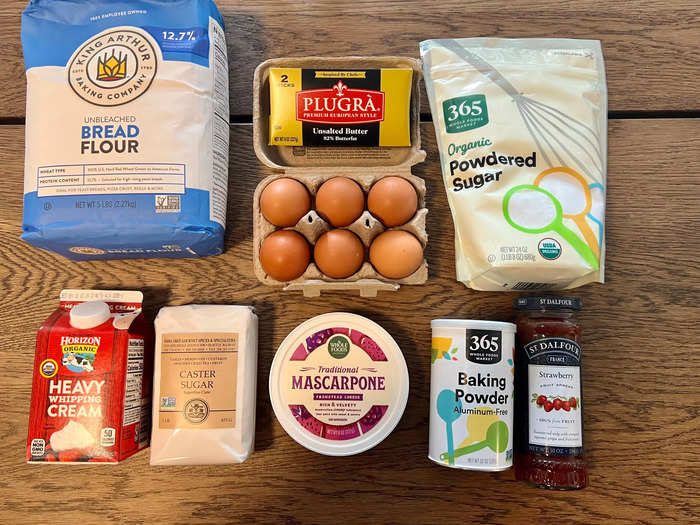
To make Hollywood's scones, you'll need:
500 grams of white bread flour, plus extra for dusting a surface
25 grams of baking powder
80 grams of unsalted butter
3 eggs, two for the mix and one to wash over the scones before baking
250 milliliters of milk
80 grams of caster sugar
Powdered sugar
Jam
Clotted cream
If you are making this recipe from the US, like I did, it might not be easy to find clotted cream at your local grocery store. Instead, I made mock clotted cream by following a recipe shared by food blogger Elizabeth Waterson on her website Confessions of a Baking Queen.
Before the baking could begin, I preheated my oven and lined two trays with baking paper.
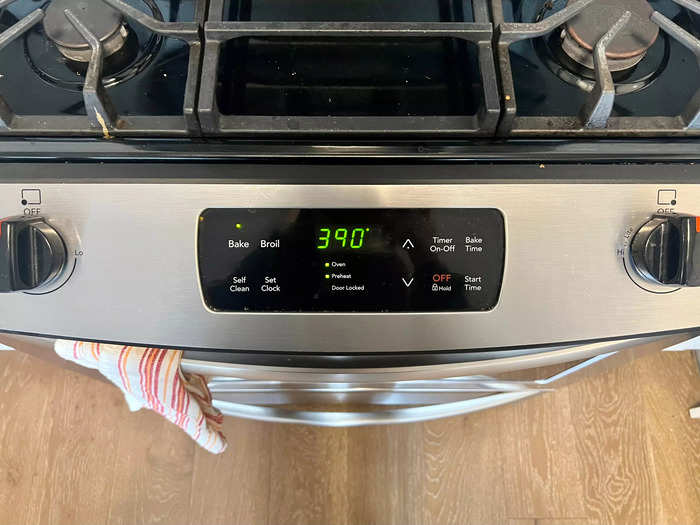
This is where I ran into my first challenge. According to Hollywood's recipe, the oven should be heated to 200 degrees Celsius, or 392 degrees Fahrenheit.
The oven I was using, however, only heated up in increments of five or 10, meaning that I could either heat it to 390 or 395 degrees Fahrenheit.
I opted for 390 degrees Fahrenheit since that was closest to the temperature Hollywood specifies but made a mental note that when it came time to put the scones in the oven, I might need to leave them in a bit longer than the recipe instructs to make sure they were baked enough.
With prep out of the way, I kicked off the baking by putting the dry ingredients into a large bowl.
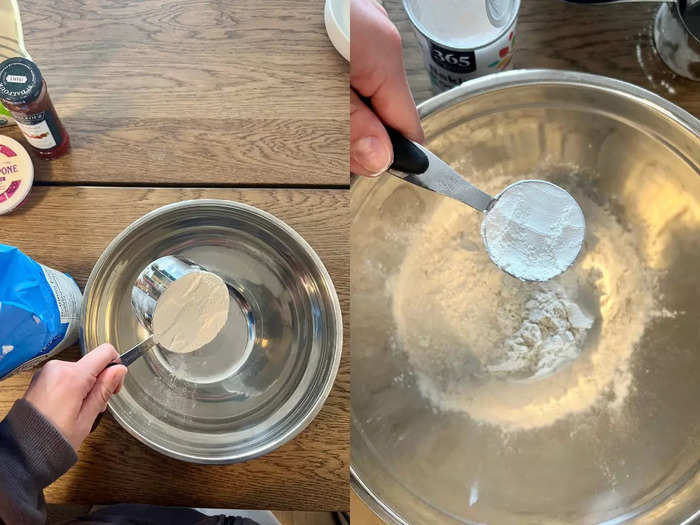
The dry ingredients consisted of the bread flour and baking powder. After adding both in, I gave the powdery substance a good mix so that they'd incorporate evenly into each other.
Next, I added the butter.
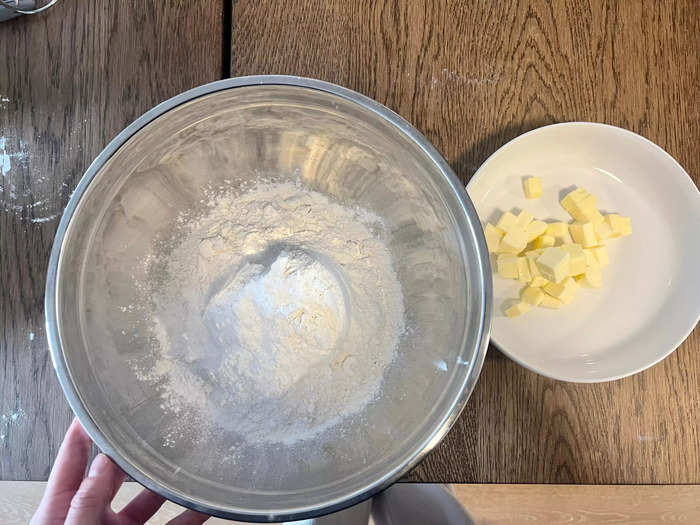
Hollywood advises using unsalted butter and chopping it into small cubes before adding it to the dry ingredients.
He doesn't say why, but I imagine it's to help the butter blend with the flour and baking powder as smoothly as possible.
I worked the butter into the dry ingredients using my hands.
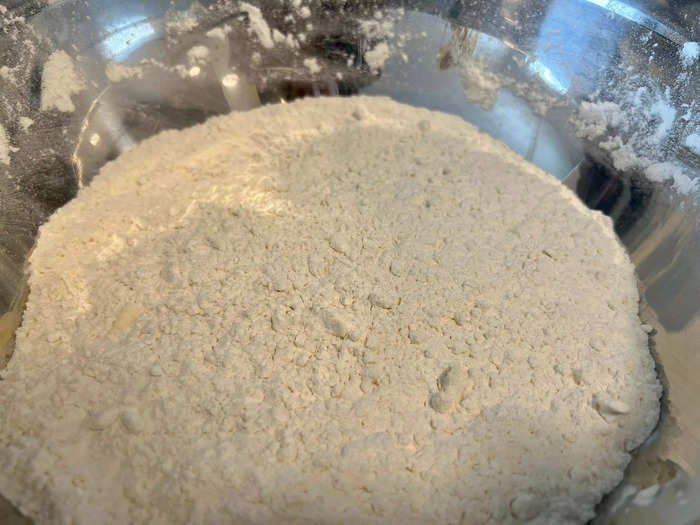
Following Hollywood's instructions, I rolled up my sleeves and used my fingers to massage the chunks of butter into the dry ingredients.
Eventually, I got it to the point where the contents of the bowl did look more like thick breadcrumbs than powder, which is what Hollywood said you need to look for.
Then it was time to add some liquids and the sugar before mixing everything together until it resembled a giant dough ball.
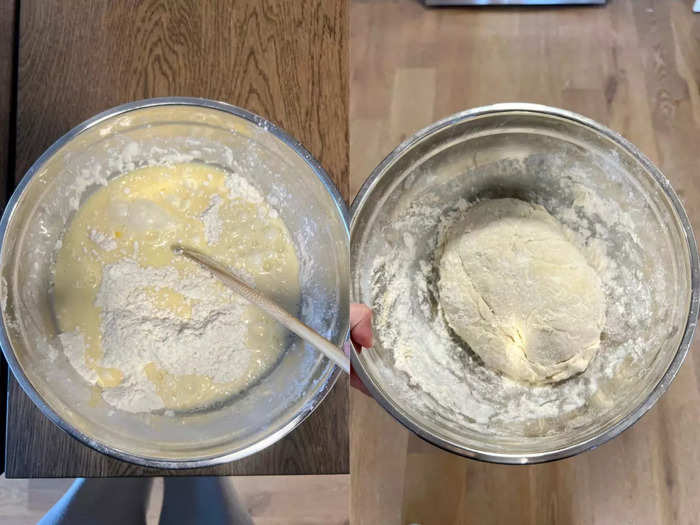
In a separate bowl to the dry ingredients, I mixed two of the three eggs the recipe calls for, milk, and caster sugar. Once the ingredients had blended into an even light-yellow liquid, I poured the contents into the large bowl with the dry ingredients.
It took a good few minutes for the mixture to look like a big ball of dough. I started the process by using a wooden spoon, but resorted to using my hands after a while, which made shaping the dough a lot easier.
The next step involved tipping the dough onto a lightly floured surface and folding it carefully.
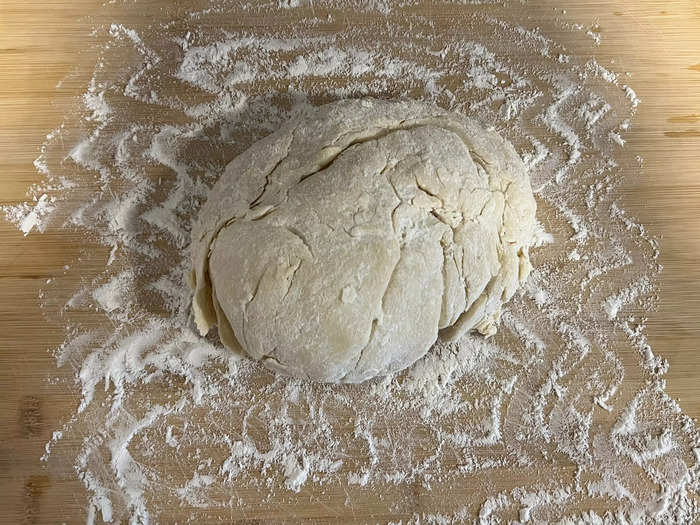
According to Hollywood, it's important to be super careful not to overwork the dough at this stage. He advises folding the dough over a few times to allow a bit of air to get into it, and he says you should avoid kneading it, which essentially means pressing and pulling it until it forms a smooth, cohesive mass.
If you do that, it's possible the scones can come out chewier and denser than they should be.
To flatten the dough, I used a wine bottle as a makeshift rolling pin.
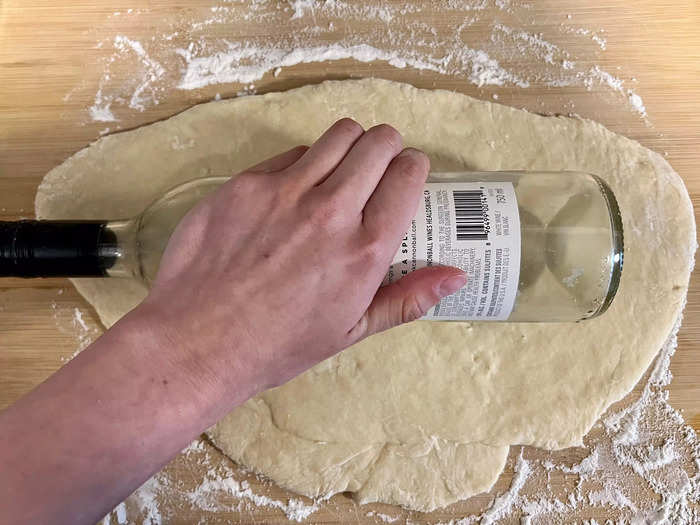
Wooden rolling pins might be a staple in your kitchen, but they aren't in mine. So when I got to the step of the recipe where you need to roll the dough out, I was briefly stumped as to how I'd manage it.
That's when I turned to a half-empty bottle of wine left in the fridge. I gave it a quick clean before using it to roll my dough until it was approximately 3 centimeters (roughly 1.1 inches) thick.
Hollywood advises using a "scone cutter" to cut out rounds of dough, but I made do with a mason jar.
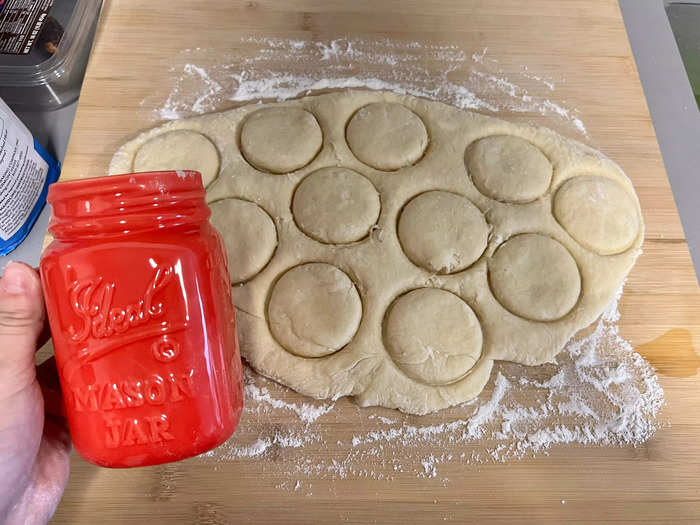
Again, I'm an amateur baker, which means I don't have all the bells and whistles that are used in baking recipes on hand. So instead of following Hollywood's instruction to use a "scone cutter," I simply used a mason jar, which worked just as well to cut the rounds.
You can also use a glass or a cookie cutter if you have one. Another piece of advice Hollywood shares at this step of the recipe is to avoid twisting whatever tool you use to cut the scone shapes out of the dough as it can lead to them not rising properly in the oven.
The last few steps before baking included brushing the scones with a beaten egg and leaving them to rest in the fridge.
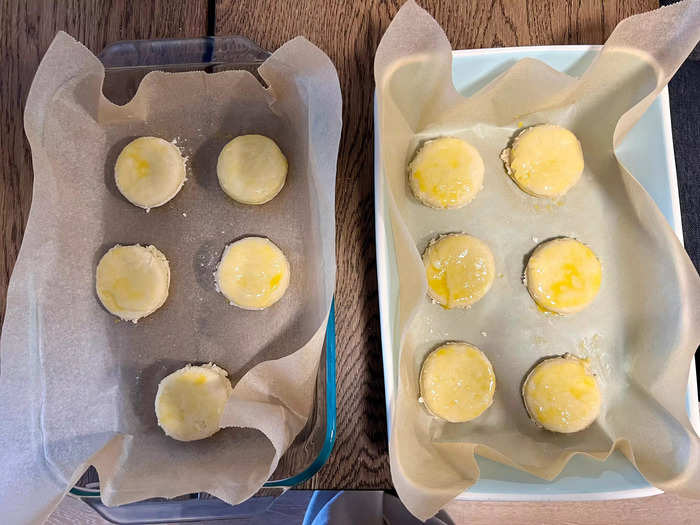
Per Hollywood's instructions, I beat the last egg the recipe calls for with a pinch of salt before brushing the mixture onto the top of the scones. I will say I only noticed later on that I did not brush the scones equally with the mixture, which might've left some looking paler and less glossy after baking.
Nonetheless, after brushing the scones with the egg wash, I let them rest in the fridge for 20 minutes.
As the scones rested, I whipped up the mock clotted cream, which only calls for three ingredients.
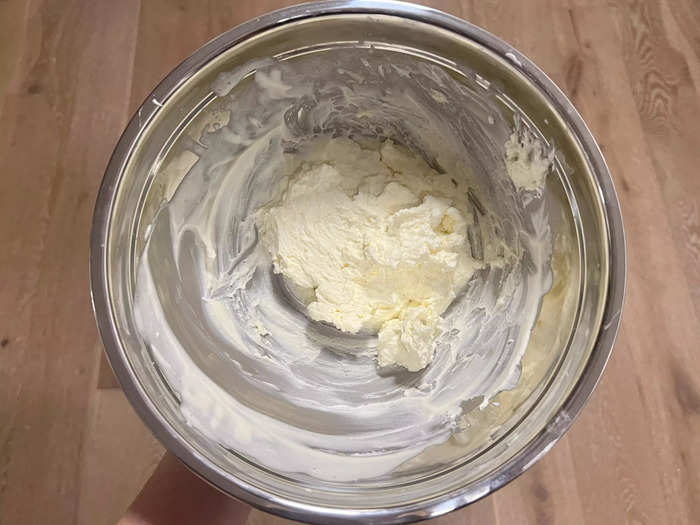
To make Waterson's mock clotted cream, you'll need:
4 ounces or ½ cup of heavy whipping cream
1 tablespoon of powdered sugar
8 ounces of softened mascarpone cheese
Per the recipe, I started by adding the heavy whipping cream and the sugar to a bowl. Using an electric whisk, I beat the mixture until it formed stiff peaks and then finished by folding in the mascarpone cheese.
The result was delicious, thick, and creamy, much like traditional clotted cream.
Once the scones were done resting, I brushed them with another layer of egg wash before popping them in the oven.
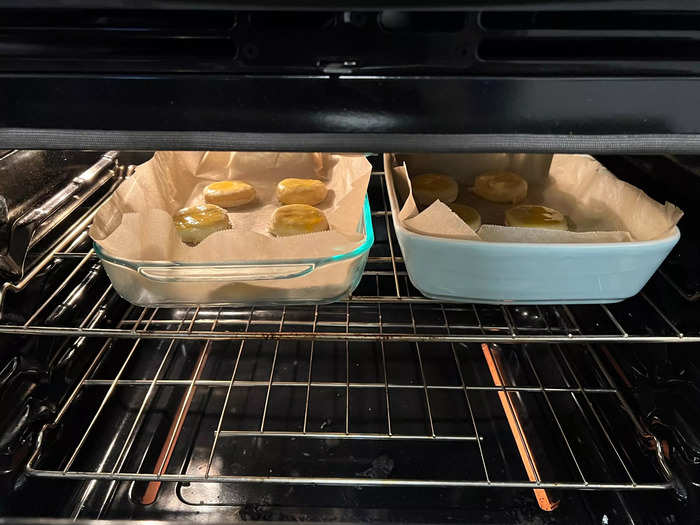
Hollywood's instructions say to bake the scones for 15 minutes. After that allotted time, he says they should be "golden brown" in hue.
But since the oven I was using didn't heat to the exact temperature his recipe outlines, I decided to play it safe and set my timer for 12 minutes and check regularly from then on.
I ended up baking the scones for closer to 17 minutes to try to achieve that "golden brown" hue Hollywood talks about, but it's safe to say I didn't quite get there.
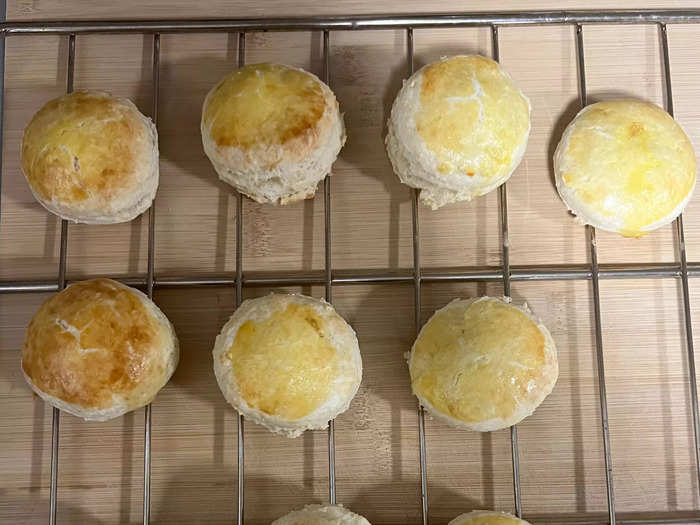
As soon as I transferred my scones onto a cool wire wrack, I could tell something was off.
They'd come out pretty uneven in color; the tops of some of the pastries had patches of golden brown while others were a weak, unappetizing yellow.
I also noticed that quite a few had cracks visible on the top and had split in the middle. These cracks indicated to me that maybe something went wrong in the way I mixed the ingredients or handled the dough.
As disappointed as I was with the initial look of the scones, it's nothing a dust of powdered sugar couldn't fix.
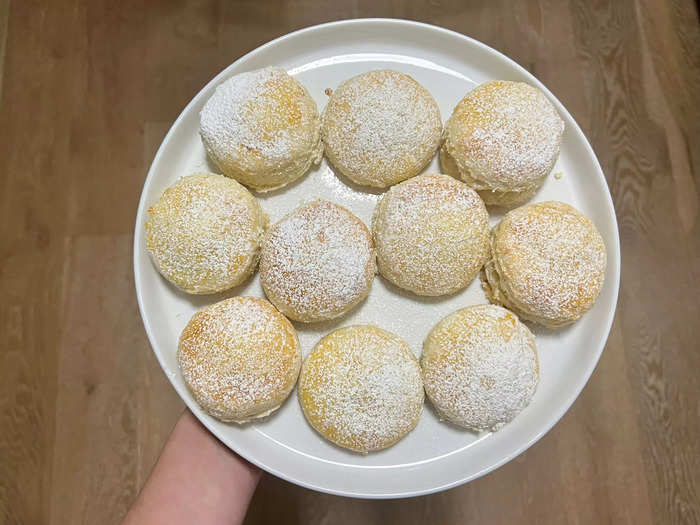
The final step of the recipe is to dust powdered sugar (also known as confectioner's sugar) across the top of all of the scones.
I went a little heavy on the powdered sugar to cover up what I saw as mistakes in my bake, and honestly, I was pretty pleased with how the scones looked after I did.
I'm a firm believer in preparing a scone with jam first and then cream.
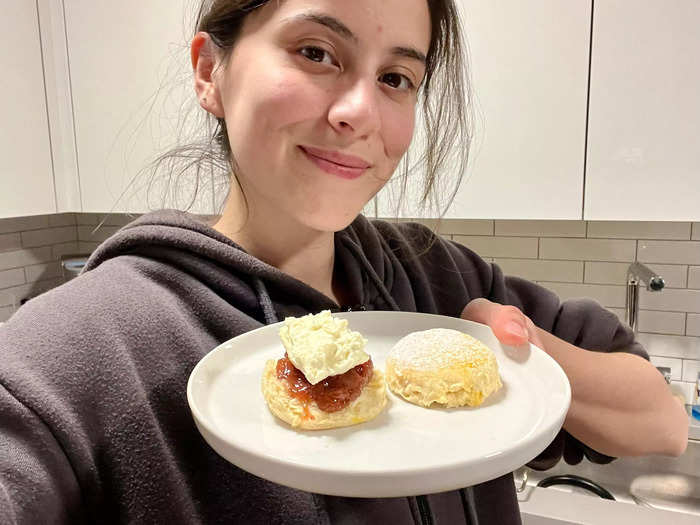
Sorry, not sorry to those who disagree, but I stand with Business Insider editor Chloé Pantazi-Wolber, who wrote that preparing scones jam-first is the best way to enjoy them.
For me, it's just logical and the way I've always eaten scones. But there are plenty of other reasons why the jam-first method is the right one. As Pantazi-Wolber reported, it's not as messy as eating it cream-first, and it's the way the late Queen Elizabeth II enjoyed her scones, according to her former chef Darren McGrady.
Visually, my scones might not have been worthy of a Hollywood handshake, but I'm pretty happy with how they tasted.
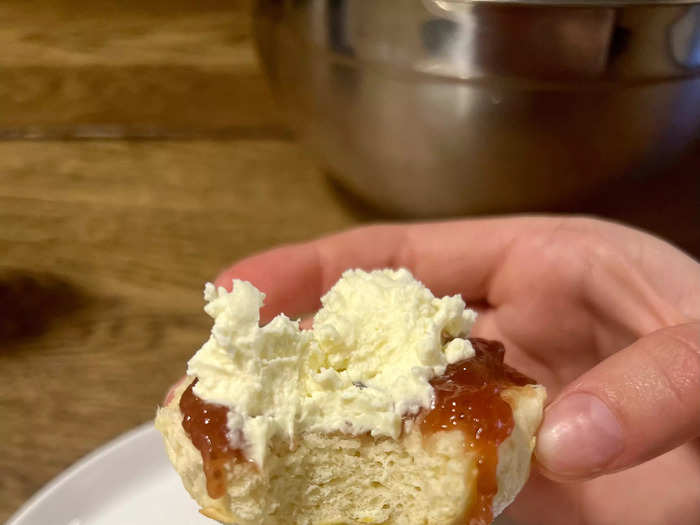
Without the heavy dusting of powdered sugar, I know very well that my scones wouldn't win any medals in the looks department, but I will say they tasted pretty spot-on.
The flavor of the scone itself was buttery but light, which made it the perfect base for the flavors of the clotted cream and jam to shine through.
I did encounter a minor texture-related issue. While the scones were moist, they were also slightly more dense than I was used to. Just as I presumed with the cracks that had formed on a few of the tops and sides of the scones, I believe this likely came from me either not combining ingredients enough during the steps involving mixing or overworking the dough.
Considering this was my first time preparing scones at home, I was pretty proud of the result. They weren't just edible — they tasted good.
I'm pretty sure Hollywood wouldn't give me a handshake for this bake. But maybe he'd crack a smile if I swore to pay closer attention to the things he said to bear in mind before making his classic scones again.
Popular Right Now
Popular Keywords
Advertisement